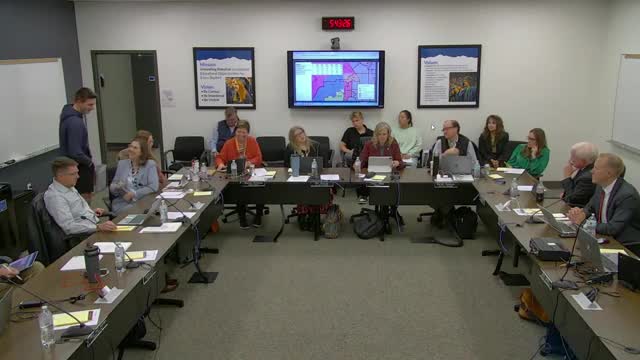Boundary Change Debate Sparks Controversy in Local Schools
November 27, 2024 | Jordan School District, Utah School Boards, Utah
This article was created by AI summarizing key points discussed. AI makes mistakes, so for full details and context, please refer to the video of the full meeting. Please report any errors so we can fix them. Report an error »

In a recent government meeting, board members engaged in a detailed discussion regarding boundary changes for local elementary schools, particularly focusing on the future of Butterfield Canyon, Aspen, Bastian, and Oakleaf schools. The conversation highlighted the complexities of managing school enrollments and the need for decisive action to address overcrowding issues.
One board member proposed moving students to Butterfield Canyon immediately, suggesting a three-year transition period for families to adjust. This proposal aimed to streamline the feeder system and alleviate pressure on Aspen Elementary, which is nearing its enrollment capacity. However, concerns were raised about the implications of such a move, particularly regarding the potential for continual adjustments to school boundaries that could disrupt families.
The discussion also included various options for boundary adjustments, labeled A, B, C, and D, with board members debating the merits of each. A significant point of contention was the impact of these changes on student populations at Bastian and Oakleaf schools. Current projections indicated that Bastian could face an enrollment of over 1,000 students next year, which would exceed its capacity.
Board members expressed a desire for a comprehensive solution rather than piecemeal adjustments, fearing that repeated minor changes could lead to confusion and dissatisfaction among families. The need for accurate enrollment numbers was emphasized, as decisions would need to be data-driven to ensure that schools do not become overcrowded.
As the meeting progressed, it became clear that any proposed changes would require further analysis and public input. The board is expected to revisit these discussions in the coming months, with a focus on creating a sustainable and equitable solution for all affected schools. The next steps include gathering more data on student populations and considering community feedback before making any final decisions.
One board member proposed moving students to Butterfield Canyon immediately, suggesting a three-year transition period for families to adjust. This proposal aimed to streamline the feeder system and alleviate pressure on Aspen Elementary, which is nearing its enrollment capacity. However, concerns were raised about the implications of such a move, particularly regarding the potential for continual adjustments to school boundaries that could disrupt families.
The discussion also included various options for boundary adjustments, labeled A, B, C, and D, with board members debating the merits of each. A significant point of contention was the impact of these changes on student populations at Bastian and Oakleaf schools. Current projections indicated that Bastian could face an enrollment of over 1,000 students next year, which would exceed its capacity.
Board members expressed a desire for a comprehensive solution rather than piecemeal adjustments, fearing that repeated minor changes could lead to confusion and dissatisfaction among families. The need for accurate enrollment numbers was emphasized, as decisions would need to be data-driven to ensure that schools do not become overcrowded.
As the meeting progressed, it became clear that any proposed changes would require further analysis and public input. The board is expected to revisit these discussions in the coming months, with a focus on creating a sustainable and equitable solution for all affected schools. The next steps include gathering more data on student populations and considering community feedback before making any final decisions.
View full meeting
This article is based on a recent meeting—watch the full video and explore the complete transcript for deeper insights into the discussion.
View full meeting

